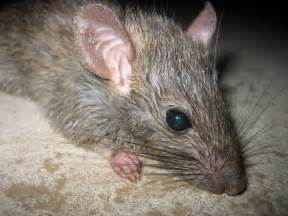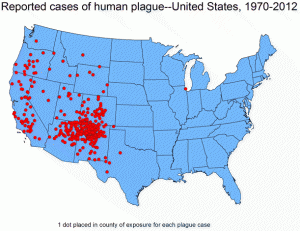Archive for the ‘Plague’ Category
Rising pneumonic plague cases in Madagascar’s largest cities: Residents waited in lines for antibiotics and bought face masks last week.
Tuesday, October 17th, 2017AP : the death toll rose to 63
- Officials canceled school
- Officials banned public gatherings
- Madagascar’s public health minister barred doctors and health care workers fom vacation until the threat subsides.
Madagascar: IFRC to deploy first-ever plague treatment centre, releases 1 million Swiss francs as infections spread
Sunday, October 15th, 2017“…..A full medical team will be deployed along with the 50-bed treatment centre that has the capacity to isolate and treat patients suffering from plague. The treatment centre will operate using national health staff in addition to the international medical team, and will significantly bolster in-country capacity to respond to the outbreak…..”
“….. Between 1 August and 12 October 2017, a total of 684 cases (suspected, probable and confirmed) including 57 deaths (case fatality rate 8.3%) have been reported from 35 out of 114 districts in the country. Of these, 474 cases (69.3%) were clinically classified as pneumonic plague, 156 (22.8%) were bubonic plague, one case was septicaemic plague, and 54 cases were unspecified. At least fifteen healthcare workers have contracted plague since the beginning of the outbreak…..”
CDC: What is the current situation in Madagascar?
Tuesday, October 10th, 2017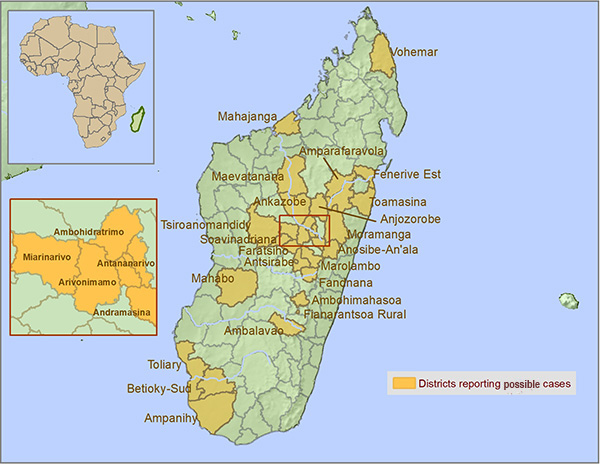
Map of Madagascar showing areas with plague. The most affected districts and cities include Antananarivo (the capital city and its suburbs), Toamasina, and the rural district of Faratsiho. Cases have also been reported in Ambatondrazaka, Ambohidratrimo, Andramasina, Ankazobe, Anosibe An’ala, Anta-Atsimondrano, Anta-Avaradrano, Anta-Renivohitra, Arivonimamo, Faratsiho, Maevatanana, Mahajanga I, Miarinarivo, Moramanga, Toamasina I, Toamasina II, Tsiroanomandidy, Vohémar, and Ambalavao
From August 23 through October 5, 2017, the World Health Organization (WHO) has reported more than 220 cases of plague in Madagascar; approximately 15% of those infected have died. Although bubonic plague occurs nearly every year in Madagascar, an unusual outbreak of plague pneumonia is occurring in geographically widespread areas, including in heavily populated cities of Antananarivo (the capital city and its suburbs) and Toamasina.* New cases continue to be reported; as of October 5, more than 120 of the cases are plague pneumonia (which can be spread from person to person) and 68 are bubonic plague (which is spread through flea bites).
In response to the outbreak, the local government is working to control fleas and is canceling mass gatherings because plague pneumonia can be spread from person to person in close contact.
The outbreak of plague in Madagascar continues to evolve. Since our last report on 4 October 2017, a total of 230 new suspected cases including 17 deaths (case fatality rate 7.4%) were reported.
Tuesday, October 10th, 2017More than a million doses of antibiotics have been delivered by the World Health Organization to fight an outbreak of plague in Madagascar which has killed at least 33 people.
Sunday, October 8th, 2017Plague – Madagascar
Saturday, September 30th, 2017
On 23 August 2017, a 31-year-old male from Tamatave, visiting Ankazobe District in central highlands, developed malaria-like symptoms. On 27 August, he developed respiratory symptoms during his journey in a shared public taxi from Ankazobe District to Tamatave (via Antananarivo). His condition worsened and he died. His body was prepared for a funeral at the nearest hospital, Moramanga District Hospital, without safety procedures. Additionally, 31 people who came into contact with this case either through direct contact with the primary case or had other epidemiological links, became ill, and four cases of them died.
The outbreak was detected on 11 September, following the death of a 47-year-old woman from Antananarivo, who was admitted to a hospital with respiratory failure caused by pneumonic plague. The public health authorities Direction de la Veille Sanitaire et de la Surveillance Epidémiologique (DVSSE) immediately launched field investigations.
As of 28 September 2017, a total of 51 cases (suspected, probable and confirmed) of pneumonic plague, including 12 deaths were reported in the country. The diagnosis was confirmed by the Institut Pasteur de Madagascar by polymerase chain reaction test and using rapid diagnostic test.
In addition to the 51 suspected, probable and confirmed cases of pneumonic plague, and during the same period another 53 cases of bubonic plague including seven deaths have been reported throughout the country. One case of septicaemic plague has also been identified and they were not directly linked to the outbreak.
Public health response
The Ministry of Health activated crisis units in Antananarivo and Toamasina and all cases have been provided access to treatment at no cost. Active case finding and contact tracing are on-going and all pneumonic cases are being isolated and treated, and all contacts are receiving chemoprophylaxis.
There are additional ongoing key public health response measures which include:
- Ongoing investigation of new cases.
- Strengthening of the epidemiological surveillance in the affected and surrounding districts, including contact identification, administration of chemoprophylaxis, and monitoring close contacts of pneumonic plague cases.
- Disinsection of affected areas, including rodent and vector control.
- Raising awareness of the population about prevention and actions after exposure.
- Raising awareness among health care workers and providing information including infection control measures, and implementation of safe burial practices.
WHO risk assessment
Plague is an infectious disease caused by the bacteria Yersinia pestis, a zoonotic bacteria, usually found in small mammals and their fleas. It is transmitted between animals from their fleas. Humans can be contaminated by the bite of infected fleas, through direct contact with infected materials or by inhalation.
There are three forms of plague infection, depending on the route of infection: bubonic, septicaemic and pneumonic.
- Bubonic plague (known in mediaeval Europe as the ‘Black Death’) is the most common form of plague and is caused by the bite of an infected flea. Plague bacillus, Yersinia pestis, enters at the bite and travels through the lymphatic system to the nearest lymph node where it replicates itself. The lymph node then becomes inflamed, tense and painful, and is called a “bubo”. At advanced stages of the infection the inflamed lymph nodes can turn into open sores filled with puss.
- Pneumonic plague-or lung-based plague- is the most virulent form of plague. Incubation period can be as short as 24 hours. Typically, the pneumonic form is caused by spread to the lungs from advanced bubonic plague. However, a person with secondary pneumonic plague may form aerosolized infective droplets and transmit plague via droplets to other humans. Untreated pneumonic plague is always fatal.
- Septicaemic plague occurs when infection spreads through the bloodstream, following a bubonic or a pneumonic plague.
Plague can be a very severe disease in people, particularly in its septicaemic and pneumonic forms, with a case-fatality ratio of 30–100% if left untreated. The pneumonic form is invariably fatal unless treated early, is especially contagious and can trigger severe epidemics through person-to-person contact via droplets in the air.
Plague is an endemic disease in Madagascar; cases of bubonic plague are reported nearly every year, during the epidemic season (between September and April). However, the ongoing pneumonic plague event has been reported in a non-endemic area and in densely populated coastal cities for the first time.
Pneumonic plague is a form of plague that is transmissible from person-to-person, with a potential to trigger severe epidemics if inadequately controlled. Detection of this outbreak occurred more than two weeks after the first case died during which cases travelled to different parts of the country, including the capital Antananarivo. Therefore, the overall risk at the national level is high. The overall regional risk is moderate due to frequent flights to neighboring Indian Ocean islands. The global risk is low.
WHO advice
Prevention and control measures
Preventive measures include informing people when zoonotic plague is present in their environment and advising them to take precautions against flea bites and not to handle animal carcasses. The most rapid and effective method for controlling fleas is to apply an appropriate insecticide formulated as a dust or low-volume spray. People, especially health workers, should also avoid direct contact with infected tissues such as buboes, or close exposure to patients with pneumonic plague. Important prevention and control measures include:
- Find and stop the source of infection.
- Protect health workers: inform and train them on infection prevention and control.
- Isolate: patients with pneumonic plague. They should be isolated so as not to infect others via air droplets.
- Surveillance: identify and monitor close contacts of pneumonic plague patients and give them a seven day chemoprophylaxis.
- Obtain specimens which should be carefully collected and sent to labs for testing.
- Ensure safe burial practices.
Treatment
Untreated plague can be rapidly fatal, so early diagnosis and treatment is essential for survival and reduction of complications. Antibiotics and supportive therapy are effective against plague if patients are diagnosed in time.
Travel advice
WHO advises against any restriction on travel or trade on Madagascar based on the available information. It is recommended to provide information at the ports of entry (airports, seaports) of Madagascar about the disease and the necessary protection measures required.
For more information, please see the WHO plague fact sheet link below:
Madagascar: 93 suspected plague patients have been registered between [1 Aug 2017] and [25 Sep 2017] and 5 of them have died
Thursday, September 28th, 2017Plague around the world, 2010–2015
E. Bertherata
“Plague is a bacterial infection mainly affecting small mammals and transmitted by fleas. The geographical distribution of the disease is very focalized. Occasionally, the pathogen Yersinia pestis can infect humans through infected flea bites. Human plague is a serious disease, particularly in its septicaemic and pneumonic forms. The pneumonic form, invariably fatal unless treated early, is especially contagious and can trigger terrifying epidemics through direct person-to-person contact. In these circumstances, plague is simultaneously a medical and a public health emergency.
Between 1 January 2010 and 31 December 2015, 3248 cases of plague in humans were reported, resulting in 584 deaths (Table 1). The principal animal reservoir (which differs from region to region) and local socioeconomic conditions are determinants of the epidemiological characteristics of the disease and the risk of transmission to humans. Plague is a disease of poverty in Africa, South America and India, where the animal reservoir essentially comprises commensal rodents, but tends to be a sporadic disease associated with outdoor occupations in the other endemic regions. ……..”
Africa
“……In Africa, 4 countries still regularly report cases. Madagascar is the most seriously affected country in the world. The surveillance system is relatively effective, thanks to the support of the national Pasteur Institute. Thus, specimens are taken from 95% of suspected cases and nearly 55% of these are confirmed as plague cases. Incidence has declined in the last 2 years but there has been an increase in the overall case fatality rate (23% in 2015) associated with the higher frequency of pneumonic forms (23.3%). This increase in serious forms of the disease is symptomatic of the deteriorating fabric of the health system as a result of the recent social and political crisis in the country. …..”
Bubonic Plague in History
Wednesday, September 27th, 2017Model-based analysis of an outbreak of bubonic plague in Cairo in 1801
“….Bubonic plague is arguably the most devastating infectious disease that mankind has ever been confronted with. Its causative agent, Yersinia pestis, has recently been detected in several human remains dated from the third millennium BCE but at that time lacked the ability to cause epidemics of bubonic plague transmitted by ectoparasites [1,2]. Genetic adaptation to the flea-borne pathogenic lifestyle is estimated to have happened shortly before the beginning of the first millennium BCE [1,3,4], which coincides with some of the first historical descriptions of epidemics that have been putatively attributed to bubonic plague. Ancient historical descriptions are, however, typically insufficient to reach a clear verdict of plague. For example, the disease that struck the Philistines in the eleventh century BCE has been proposed to be the earliest known outbreak of bubonic plague, but could in fact have been caused by dysentery or tularaemia [5,6]. Likewise, the outbreak that ravaged Athens in 430 BCE could have been a number of infectious diseases other than plague, such as Ebola [7,8]. Although there would certainly have been earlier cases at least sporadically, the first human deaths that have been conclusively attributed to Y. pestis using DNA evidence occurred in the sixth century CE, during the so-called plague of Justinian [9,10]. This epidemic was first reported by the contemporary historian Procopius in Egypt in 541 CE, and it would have spread rapidly on ships carrying grain to Constantinople and throughout the Byzantine empire [11]. The first plague pandemic followed, which ravaged Mediterranean and European regions through several waves over the next 200 years [12]. The second plague pandemic started in 1347 with the so-called Black Death epidemic. Once again, DNA evidence has been used to incriminate Y. pestis as the infectious agent [13,14]. The epidemic originated in Central Asia before spreading throughout Europe via trade routes [15]. In Western Europe, the second pandemic lasted until the end of the seventeenth century, with the Marseilles plague of 1720 being an exceptionally late outbreak [16]. For example, in England, the last major outbreak took place in 1665 in London and a few secondary locations [17,18]. Finally, a third pandemic started around 1855 which ravaged China and India for almost a century, and during which the causative bacteria Y. pestis was discovered as well as its flea-borne mode of transmission [19].
Phylogenetic evidence indicates that the third pandemic was caused by a direct descendant from the lineage that had caused the second pandemic [10,15]. Between the end of the second and the beginning of the third pandemic, this lineage would have been restricted to the Middle East [10]. Outbreaks of bubonic plague were indeed regularly reported during the interpandemic period, for example, in Iraq [20], in Syria [21] and in Egypt [21–25]. A comprehensive survey of historical reports of epidemics shows that throughout the eighteenth century and the first half of the nineteenth century, plague was documented in Asia Minor in approximately 85% of years, in Lower Egypt in approximately 30% of years and in Syria in approximately 20% of years [26]. This recurrence of plague in the Middle East at a time when Europe was free of it significantly contributed to the weakening of the Ottoman Empire [22]. Several Western visitors were surprised by the lack of measures taken by the local population to try and protect itself from the disease [25,26]. Very high plague death tolls were recorded by contemporary writers, but many of these were exaggerated and the aetiology is often unclear [25,27]. Thus, although it is beyond doubt that the Middle East was frequently hit by plague between 1700 and 1850, little is known about this important connecting link between the second and third pandemics, and there are virtually no reliable data available for formal epidemiological investigation.
A notable exception concerns the short period from 1798 to 1801 during which a French revolutionary expedition into Ottoman Egypt was led by the future emperor Napoleon Bonaparte. Many French scientists accompanied this expedition, who studied many aspects of the Egyptian country they visited, such as its topography, climate, history, demography and languages. The expedition included a large number of medical officers headed by René Desgenettes who together collected a wealth of medical observations about the health of the Egyptian population [28,29]. Upon his return, Desgenettes reported his findings in a book entitled ‘Histoire médicale de l’armée d’Orient’ which includes a table of the daily number of deaths recorded among men, women and children living in Cairo [30]. This daily mortality statistical table covers an epidemic of plague that took place in early 1801 and which is briefly mentioned in Desgenettes’ book [30] as well as a few monographs written by other medical officers returning from the French expedition [31–33] and secondary sources [34–36]. These data present a unique opportunity to dissect how an outbreak of bubonic plague unfolded in interpandemic Egypt….”
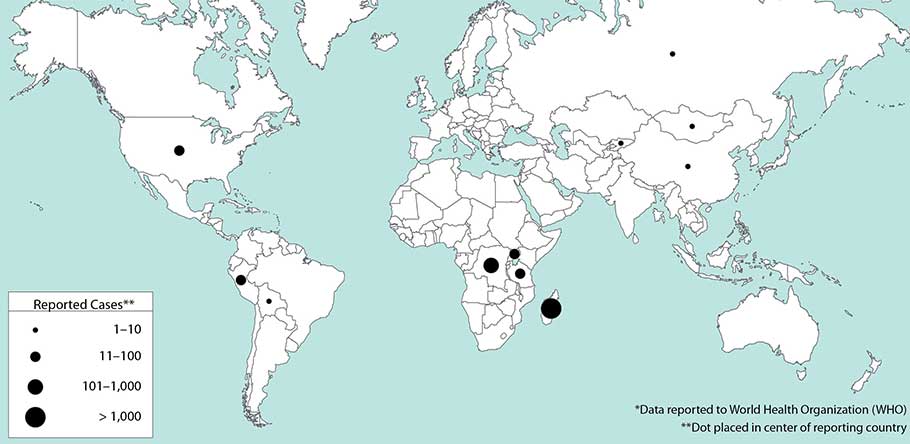
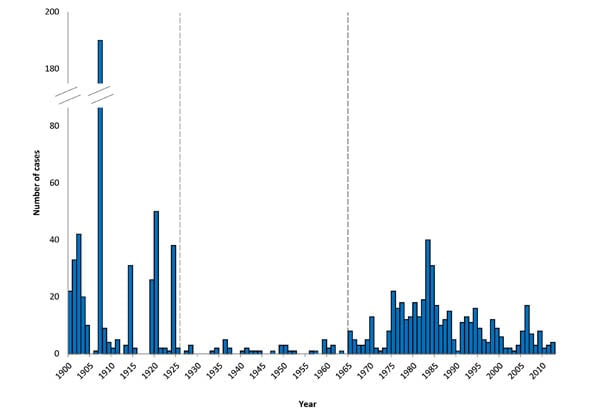


3 human plague cases from Santa Fe County, NM in 2017
Tuesday, June 27th, 2017
Additional Cases of Human Plague in Santa Fe County
Second and Third Cases Reported This Year
The New Mexico Department of Health (NMDOH) is reporting two recent confirmed plague cases in 52-year-old and 62-year-old females from Santa Fe County. With the addition of these cases, there have been three human plague cases from Santa Fe County in 2017. All three cases required hospitalization. There have been no deaths from plague in 2017.
NMDOH conducted environmental investigations around the homes of the patients to look for ongoing risk and to ensure the safety of the immediate family and neighbors.
Plague is a bacterial disease of rodents and is generally transmitted to humans through the bites of infected fleas, but can also be transmitted by direct contact with infected animals, including rodents, wildlife and pets. Plague can be present in fleas that infest wild rodents in Santa Fe County, including the city limits of Santa Fe, and several other New Mexico counties.
“Pets that are allowed to roam and hunt can bring infected fleas from dead rodents back into the home, putting you and your children at risk,” said Dr. Paul Ettestad, public health veterinarian for the Department of Health. “Keeping your pets at home or on a leash and using an appropriate flea control product is important to protect you and your family.”
To prevent plague, the Department of Health also recommends:
- Talk to your veterinarian about using an appropriate flea control product on your pets as not all products are safe for cats, dogs, or your children.
- Clean up areas near the house where rodents could live, such as woodpiles, brush piles, junk and abandoned vehicles.
- Sick pets should be examined promptly by a veterinarian.
- See your doctor about any unexplained illness involving a sudden and high fever.
- Put hay, wood, and compost piles as far as possible from your home.
- Don’t leave your pet’s food and water where mice can get to it.
Symptoms of plague in humans include sudden onset of fever, chills, headache, and weakness. In most cases there is a painful swelling of the lymph node in the groin, armpit or neck areas. Plague symptoms in cats and dogs are fever, lethargy and loss of appetite. There may be a swelling in the lymph node under the jaw. With prompt diagnosis and appropriate antibiotic treatment, the fatality rate in people and pets can be greatly reduced. Physicians who suspect plague should promptly report to the Department of Health.
In New Mexico, there were four human plague cases in 2016 in Bernalillo, Mora and Rio Arriba counties with no fatalities; and four human plague cases in 2015 in Bernalillo and Santa Fe counties with one fatality.
For more information on plague, including fact sheets in English and Spanish, visit the Plague section of our website.



